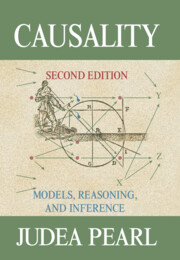Book contents
- Frontmatter
- Dedication
- Contents
- Preface to the First Edition
- Preface to the Second Edition
- 1 Introduction to Probabilities, Graphs, and Causal Models
- 2 A Theory of Inferred Causation
- 3 Causal Diagrams and the Identification of Causal Effects
- 4 Actions, Plans, and Direct Effects
- 5 Causality and Structural Models in Social Science and Economics
- 6 Simpson’s Paradox, Confounding, and Collapsibility
- 7 The Logic of Structure-Based Counterfactuals
- 8 Imperfect Experiments: Bounding Effects and Counterfactuals
- 9 Probability of Causation: Interpretation and Identification
- 10 The Actual Cause
- 11 Reflections, Elaborations, and Discussions with Readers
- Epilogue The Art and Science of Cause and Effect
- Bibliography
- Name Index
- Subject Index
5 - Causality and Structural Models in Social Science and Economics
Published online by Cambridge University Press: 05 March 2013
- Frontmatter
- Dedication
- Contents
- Preface to the First Edition
- Preface to the Second Edition
- 1 Introduction to Probabilities, Graphs, and Causal Models
- 2 A Theory of Inferred Causation
- 3 Causal Diagrams and the Identification of Causal Effects
- 4 Actions, Plans, and Direct Effects
- 5 Causality and Structural Models in Social Science and Economics
- 6 Simpson’s Paradox, Confounding, and Collapsibility
- 7 The Logic of Structure-Based Counterfactuals
- 8 Imperfect Experiments: Bounding Effects and Counterfactuals
- 9 Probability of Causation: Interpretation and Identification
- 10 The Actual Cause
- 11 Reflections, Elaborations, and Discussions with Readers
- Epilogue The Art and Science of Cause and Effect
- Bibliography
- Name Index
- Subject Index
Summary
Do two men travel together unless they have agreed?
Amos 3:3Preface
Structural equation modeling (SEM) has dominated causal analysis in economics and the social sciences since the 1950s, yet the prevailing interpretation of SEM differs substantially from the one intended by its originators and also from the one expounded in this book. Instead of carriers of substantive causal information, structural equations are often interpreted as carriers of probabilistic information; economists view them as convenient representations of density functions, and social scientists see them as summaries of covariance matrices. The result has been that many SEM researchers have difficulty articulating the causal content of SEM, and the most distinctive capabilities of SEM are currently ill understood and underutilized.
This chapter is written with the ambitious goal of reinstating the causal interpretation of SEM. We shall demonstrate how developments in the areas of graphical models and the logic of intervention can alleviate the current difficulties and thus revitalize structural equations as the primary language of causal modeling. Toward this end, we recast several of the results of Chapters 3 and 4 in parametric form (the form most familiar to SEM researchers) and demonstrate how practical and conceptual issues of model testing and parameter identification can be illuminated through graphical methods. We then move back to nonparametric analysis, from which an operational semantics will evolve that offers a coherent interpretation of what structural equations are all about (Section 5.4). In particular, we will provide answers to the following fundamental questions: What do structural equations claim about the world? What portion of those claims is testable? Under what conditions can we estimate structural parameters through regression analysis?
In Section 5.1 we survey the history of SEM and suggest an explanation for the current erosion of its causal interpretation. The testable implications of structural models are explicated in Section 5.2. For recursive models (herein termed Markovian), we find that the statistical content of a structural model can be fully characterized by a set of zero partial correlations that are entailed by the model. These zero partial correlations can be read off the graph using the d-separation criterion, which in linear models applies to graphs with cycles and correlated errors as well (Section 5.2).
- Type
- Chapter
- Information
- CausalityModels, Reasoning, and Inference, pp. 133 - 172Publisher: Cambridge University PressPrint publication year: 2009
- 2
- Cited by

